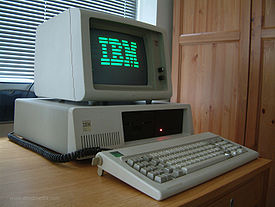- IBM Personal Computer XT
-
IBM PC/XT (model 5160) 
Release date March 8, 1983 Discontinued April 1987 Operating system IBM BASIC / PC DOS 2.0-3.20 / SCO Xenix CPU Intel 8088 @ 4.77 MHz Memory 128-640 kB The IBM Personal Computer XT, often shortened to the IBM XT, PC XT, or simply XT, was IBM's successor to the original IBM PC. It was released as IBM Machine Type number 5160 on March 8, 1983, and came standard with a hard drive. It was based on essentially the same architecture as the original PC, with only incremental improvements; a new 16-bit bus architecture would follow in the AT. The XT was mainly intended as an enhanced machine for business use, and a corresponding 3270 PC featuring 3270 terminal emulation was released later in October 1983. XT stands for X-tended Technology.
Contents
Features
The standard XT originally came with 128 kB of RAM, a 360 kB double-sided 5.25 in (133 mm) full-height floppy disk drive, a 10 MB Seagate ST-412 hard drive with Xebec 1210 MFM controller, an Asynchronous Adapter (serial card with 8250 UART) and a 130 watt power supply.[1] The motherboard had eight 8-bit ISA expansion slots, and an Intel 8088 microprocessor running at 4.77 MHz (with a socket for an 8087 math coprocessor); the operating system usually sold with it was PC DOS 2.0 and above. The eight expansion slots were an increase over the five in the IBM PC, although three were taken up by the floppy drive and hard drive adapters, and the Async card. The basic specification was soon upgraded to have 256 kB of RAM as standard. Slot 8 on the XT motherboard was wired slightly different than the other slots, making it incompatible with some cards. This was done for cards designed to allow the XT to be connected to IBM mainframes. Video cards initially comprised the MDA and CGA, with EGA and PGC becoming available in 1984.
There were two widely used configurations of the XT motherboard. The first could support up to 256 kB on the motherboard itself (four banks of 64 kB chips), with a maximum of 640 kB achieved by using expansion cards. This was the configuration the XT originally shipped in. The second configuration—introduced in stock units in 1986—could support the whole 640 kB on the motherboard (two banks of 256 kB chips, two banks of 64 kB), had the later revision AT-compatible BIOS with a faster booting time, as well as support for 101-key keyboards and 3.5 in (89 mm) floppy drives. The earlier configuration could be adapted to "late" configuration after a couple of minor modifications.[1]
There were also two or three revisions of the motherboard; however, there are only minor differences between them. Most notable is that the first revision is missing U90 and has some parts located at another place on the motherboard. The change occurred in the spring of 1984, when IBM stopped the production of submodel 087 and began producing the submodel 086 instead. However, the motherboard revision and the fact that 086 came with 256 kB RAM from the factory—whereas 087 came with only 128 kB RAM—are the only differences between the two first submodels.
Beginning in 1985, the XT was offered in floppy-only models without a hard drive (submodel 068 and 078).[1] XTs with the 256-640 kB motherboard configuration came standard with half-height floppy drives in place of the full-height drives, as well as the option for a 20 MB ST-225 half-height hard drive and "enhanced" keyboard (essentially a Model M without the LED panel, and cross-compatibility between the AT and XT keyboard transfer protocol). The XT was discontinued in the spring of 1987, replaced by the PS/2 Model 30.
Like the original PC, the XT came with BASIC in its ROM. Despite the lack of a cassette port on XTs, IBM's licensing agreement with Microsoft forced them to include BASIC on all their machines.
PC and XT keyboards are not compatible with those on more modern PCs (IBM AT or newer)—even with DIN to PS/2 mini-DIN plug adapters—because PC/XT keyboards have a different transfer protocol from PC/AT keyboards, as well as using different keyboard scan codes. Some keyboards are switchable between the two interfaces for compatibility with either computer. However, the newer 101-key keyboard based on the Model M will work with modern PCs.
The XT had a desktop case similar to that of the PC. It weighed 32 pounds, and was approximately 19.5 inches wide by 16 inches deep by 5.5 inches high. The power supply was configured for 120 V AC only and could not be used with 240 V supplies. [1]
IBM XT 286
In 1986, the XT 286 (IBM 5162) with a 6 MHz Intel 80286 processor was introduced. However, this system turned out to be faster than the ATs of the time using 8 MHz 286 processors because the XT 286 had zero wait state RAM, which could move data more quickly.[1]
 The IBM XT came with documentation giving the schematic diagrams, BIOS listing, character set, specifications and other detailed technical information.
The IBM XT came with documentation giving the schematic diagrams, BIOS listing, character set, specifications and other detailed technical information.
See also
References
- ^ a b c d e Scott Mueller, "Upgrading and Repairing PCs 2nd Edition" Que Books, 1992 ISBN 0-88022-856-3, pp. 59-79
- IBM (1983). Personal Computer Hardware Reference Library: Guide to Operations, Personal Computer XT. IBM Part Number 6936831.
Preceded by
IBM Personal ComputerIBM Personal Computers Succeeded by
IBM Personal Computer/ATCategories:- IBM personal computers
- 1983 introductions
Wikimedia Foundation. 2010.
